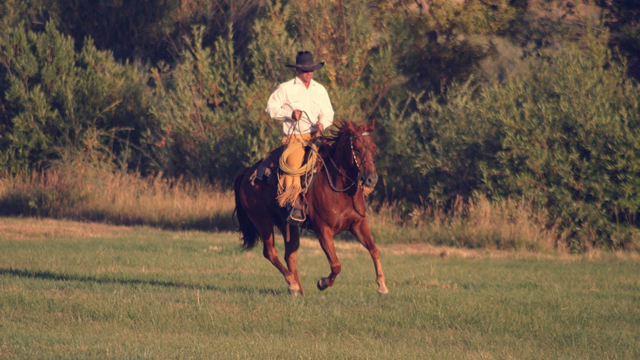Written by Martin Black
This article originally appeared in Eclectic Horseman Issue No.70
What is important to me, and what I feel is important for a horse, is for him to feel the rhythm of our body and try to be in sync with it. If a horse is not responding to our body rhythm in a slower gait, it can be more obvious in a lope.
You may want to ride slow on a horse that wants to go fast or you may want to ride faster on a horse that wants to go slow. I don’t think you should have to be holding a horse to keep him from speeding up or whipping and spurring a horse to keep him from slowing down.
We can start to develop a feel in a walk or a trot by offering the horse a chance to feel our body rhythm. If the horse is traveling slow get your rhythm with the horse then slightly speed your body rhythm up for just two or three strides and if you don’t get a slight change, where the horse tries to speed up to be with you, use your legs to kick him or spank him on the butt abruptly, then repeat the process until the horse follows your rhythm.
At first it may not be important that he maintains the speed with you, but what is important is that he makes a change. If he makes a change then you may let him go back to his original speed, then ask again.
If he stays at that speed a few strides and slows down, let him slow down, then repeat the process. This will do two things; it gives you more time to practice making the change which should get him more sensitive to making the change, and it will get him to where he would rather stay with you rather than go through repeating the process of changing.
The same process would apply on a horse that wants to be faster than you want to go. If you are in rhythm with the horse at his pace so he can feel what that feels like, then slow your body rhythm down for a few strides. If he doesn’t acknowledge or make a change then take ahold of the reins and get a change, then turn him loose. Once this is working for you slow, then you can start bringing in more speed and work on maintaining the same communication. Again, it is more important for the horse to experience the change than to try to maintain the speed.
Something we want to be careful of is that we don’t start the process that I call “boiling the frog.” The horse is well aware of the change in our body rhythm; the problem might be that it doesn’t have any meaning. All horses like being comfortable. If we make the undesirable uncomfortable by using pressure and we make the desirable comfortable by giving them relief they will be motivated to do the desirable.
The more sensitive we can be to the horse, the more sensitive the horse can be to us. We need to feel the slightest change or try in the horse in order to reward him with comfort when he does what we want and at the same time if he makes a change that we don’t want, we need to make it uncomfortable so he will want to change to find a more desirable place to be.
The horse feels our rhythm every stride. He can acknowledge it in one stride, then he can make a change in the second or third stride. But if he goes 4 or 5 strides without the change, that means that you could be getting him desensitized to the feel. This is where it’s very important to get a change so the horse understands how and where to get away from the pressure and not just learn to tolerate it.
This article originally appeared in Eclectic Horseman Issue No.70
https://eclectic-horseman.com/mercantile/horse-training-dvds/fundamental-horse-training/martin-black-roundpen-to-arena-series/


